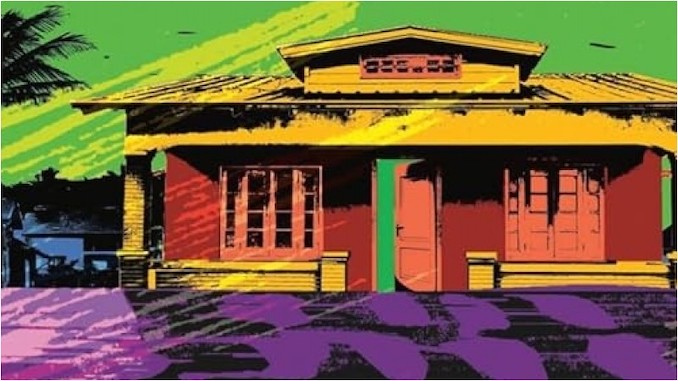Gabino Iglesias Talks Building a Horror Mythos In House of Bone and Rain

Two years ago this month, author Gabino Iglesias released his breakthrough novel, The Devil Takes You Home. A dizzying blend of crime fiction and horror that Iglesias himself terms “barrio noir,” the book went on to win both the Bram Stoker and Shirley Jackson awards for Best Novel, firmly establishing Iglesias as one of the most important genre voices on the modern horror scene. Now, Iglesias returns with House of Bone and Rain, a revenge story wrapped in a supernatural mystery set in his homeland of Puerto Rico.
As a hurricane rips through the island, devastating its inhabitants and stirring up old secrets, the book follows five friends who set out to right a few wrongs, even if it means taking on forces bigger than any of them can even conceive. It arrives as one of the most anticipated horror novels of the year, and even with the long shadow of The Devil Takes You Home in mind, it more than lives up to the hype.
Ahead of House of Bone and Rain‘s release, Paste sat down with Iglesias to discuss the book’s origins, how he built his own supernatural mythos in his native Puerto Rico, and much more.
(This interview has been edited and condensed for content and clarity.)
Paste Magazine: You’ve mentioned that this story began for you back in Puerto Rico in 1999. What did House of Bone and Rain look like back then, and why was now the right time to dive back into it?
Gabino Iglesias: It was not good [in 1999]. It was a basic story. I was like, “Well, this happened to us and I really wish we had done something more.” We didn’t, we’re not badasses in a Quentin Tarantino movie, but what if we’d gone ahead and found some information? What if we’d actually pursued this thing? Back then, it was just a crime fiction narrative about young men going out and very stupidly getting into a lot of trouble and finding revenge. And I didn’t know how to make that happen. It’s a cool idea, but I didn’t think I had the chops.
You have to juggle a bunch of characters, and it was the second novel that I was going to set at home [in Puerto Rico]. I knew that there was going to be some politics that I was going to talk about colonialism and the state of the country. So for basically two decades, I couldn’t bring myself to touch it. It was too daunting of a task. The success of The Devil Takes You Home made me think maybe this is the time, I can try to do this now. I think I’ve learned a thing or two by reading and writing for the past 20 years. So maybe now’s the time. And that core, the seed remained the same. It was five dudes going out to get revenge. And yeah, it was a lot of fun to write. Finally, to get it out felt like surgery, to take that thing out after so many years.
Paste: So if it started as a crime novel, when did the supernatural horror part start to come out for you?
Iglesias: It’s a very natural process. I’m a pantser, but I do have a beginning, a middle, and an end, and then I know that sometimes the elements that are going to be the elements of cohesion, they come to me, and I’m like, “I’m going to run with that.” In this case, I knew there was going to be a hurricane. I knew I wanted to talk about the deplorable state of our grid, and the fact that the government is corrupt. My parents are still back on the island. They haven’t had a Monday through Sunday of power since [Hurricane] Maria happened. And they’re not alone. That’s on a national level. It’s still a catastrophe.
So I knew I wanted to talk about that, but it’s such a powerful thing. It’s so packed with fear and grief after, that I knew it was going to be a bigger character. So I started looking for ways of using that supernatural angle that I enjoy so much, which is the powerful thing that calls to me from horror fiction. And in the process of not writing this novel, but learning stuff, I learned that a hurricane is basically a word that we use that comes from the Taino word, hurakán, which was the bad, the evil God, the angry God that destroyed everything. And I was like, “What if I can take this a step further and then make this an entirely new mythology?” And I knew I wanted to play with some Lovecraftian elements. Those were already there, but then I had to bring my own to make it interesting. And the hurricane was the way to go, the way to make everything darker and a little bit scarier, a little bit more dangerous.
So I sit there and I think about it until it coalesces into something that might make sense if I try to write it, and then I just go for it. So I let it happen. I think every book has its own thing. With this one, it was just, “It’s time to take one step forward and make my own thing.” Every big name in horror that I admire has the mythos. You can talk about the Brian Keane mythos the Josh Malerman mythos, and the Paul Tremblay mythos. So it felt like it was time, and that was my way of doing it.
-

-

-

-

-

-

-

-

-

-

-

-

-

-

-

-

-

-

-

-

-

-

-

-

-

-

-

-

-

-

-

-

-

-

-

-

-

-

-

-








































